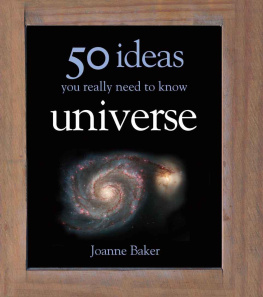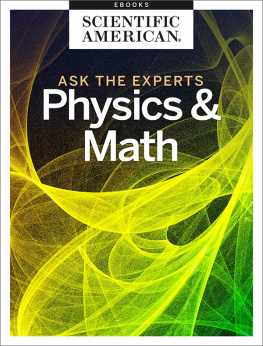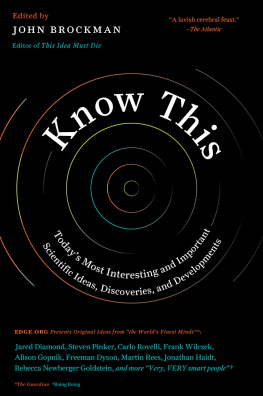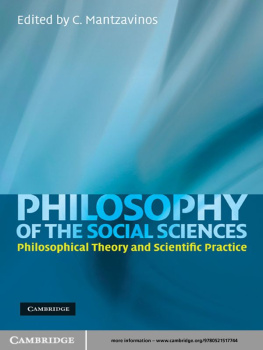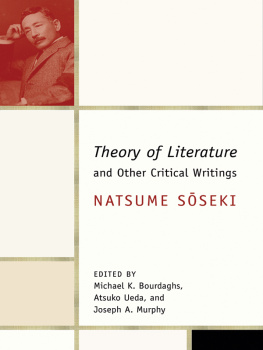physics ideas
you really need to know
Joanne Baker

Contents
MATTER IN MOTION
BENEATH THE WAVES
QUANTUM CONUNDRUMS
SPLITTING ATOMS
SPACE AND TIME
Introduction
When I told my friends about this book they joked that the first thing you really need to know about physics is that it is hard. Despite this, we all use physics every day. When we look in a mirror, or put on a pair of glasses we are using the physics of optics. When we set our alarm clocks we track time; when we follow a map we navigate geometric space. Our cell phones connect us via invisible electromagnetic threads to satellites orbiting overhead. But physics is not all about technology. Without it there would be no moon, no rainbows, no diamonds. Even the blood flowing through our arteries follows the laws of physics, the science of the physical world.
Modern physics is full of surprises. Quantum physics turned our world upside down by questioning the very concept of an objects existence. Cosmology asks what the universe is. How did it arise and why are we here? Is our universe special or somehow inevitable? Peering inside atoms, physicists uncovered a hidden ghostly world of fundamental particles. Even the most solid mahogany table is mostly made of empty space, its atoms supported by a scaffolding of nuclear forces. Physics grew out of philosophy, and in a way it is turning back toward it by providing new and unexpected views of the world that surpass our daily experiences.
However, physics is not just a collection of imaginative ideas. It is rooted in fact and experiment. The scientific method continually upgrades the laws of physics, like computer software, as bugs are fixed and new modules added. If the evidence requires it, major shifts in thinking can be accommodated, but acceptance takes time. It took more than a generation for Copernicuss idea that the Earth goes around the Sun to be widely accepted, but the pace has quickened and quantum physics and relativity were integrated into physics within a decade. So even the most successful laws of physics are constantly being tested.
This book offers you a whistle-stop tour of the world of physics, from basic concepts like gravity, light and energy through to modern ideas of quantum theory, chaos and dark energy. I hope that, like a good tourist guidebook, it tempts you to find out more. Physics is not just fundamentalit is fun.
Machs principle
A child whirling on a merry-go-round is tugged outward by the distant stars. This is Machs principle that mass there influences inertia here. Through gravity, objects far away affect how things move, and spin, nearby. But why is this and how can you tell if something is moving or not?
If you have ever sat in a train at a station and seen through the window a neighboring carriage pull away from yours, you will know that sometimes it is hard to tell whether it is your own train leaving the station or the other arriving. Is there a way that you could measure for sure which one is in motion?
Ernst Mach, Austrian philosopher and physicist, grappled with this question in the 19th century. He was treading in the footsteps of the great Isaac Newton who had believed, unlike Mach, that space was an absolute backdrop. Like graph paper, Newtons space contained an engraved set of coordinates and he mapped all motions as movements with respect to that grid. Mach, however, disagreed, arguing instead that motion was only meaningful if measured with respect to another object, not the grid. What does it mean to be moving if not relative to something else? In this sense Mach, who was influenced by the earlier ideas of Newtons competitor Gottfried Leibniz, was a forerunner to Albert Einstein in preferring to think that only relative motions made sense. Mach argued that because a ball rolls in the same way whether it is in France or Australia, the grid of space is irrelevant. The only thing that can conceivably affect how the ball rolls is gravity. On the Moon the ball might well roll differently because the gravitational force pulling on the balls mass is weaker there. Because every object in the universe exerts a gravitational pull on every other, each object will feel each others presence through their mutual attractions. So motion must ultimately depend on the distribution of matter, or its mass, not on the properties of space itself.
Absolute space, of its own nature without reference to anything external, always remains homogenous and immovable.
Isaac Newton, 1687
Mass What exactly is mass? It is a measure of how much matter an object contains. The mass of a lump of metal would be equal to the sum of the masses of all the atoms in it. Mass is subtly different from weight. Weight is a measure of the force of gravity pulling a mass downan astronaut weighs less on the Moon than on Earth because the gravitational force exerted by the smaller Moon is less. But the astronauts mass is the samethe number of atoms he contains has not changed. According to Albert Einstein, who showed that energy and mass are interchangeable, mass can be converted into pure energy. So mass is, ultimately, energy.
Inertia Inertia, named after the Latin word for laziness, is very similar to mass but tells us how hard it is to move something by applying a force. An object with large inertia resists movement. Even in outer space a massive object takes a large force to move it. A giant rocky asteroid on collision course with the Earth may need a huge shove to deflect it, whether it is created by a nuclear explosion or a smaller force applied for a longer time. A smaller spacecraft, with less inertia than the asteroid, might be maneuvered easily with tiny jet engines.
The Italian astronomer Galileo Galilei proposed the principle of inertia in the 17th century: if an object is left alone, and no forces are applied to it, then its state of motion is unchanged. If it is moving, it continues to move at the same speed and in the same direction. If it is standing still it continues to do so. Newton refined this idea to form his first law of motion.
Newtons bucket Newton also codified gravity. He saw that masses attract one another. An apple falls from a tree to the ground because it is attracted by the Earths mass. Equally, the Earth is attracted by the apples mass, but we would be hard pressed to measure the microscopic shift of the whole Earth toward the apple.
Newton proved that the strength of gravity falls off quickly with distance, so the Earths gravitational force is much weaker if we are floating high above it rather than on its surface. But nevertheless we would still feel the reduced pull of the Earth. The further away we go the weaker it would get, but it could still tweak our motion. In fact, all objects in the universe may exert a tiny gravitational pull that might subtly affect our movement.
Newton tried to understand the relationships between objects and movement by thinking about a spinning bucket of water. At first when the bucket is turned, the water stays still even though the bucket moves. Then the water starts to spin as well. Its surface dips as the liquid tries to escape by creeping up the sides but it is kept in place by the buckets confining force. Newton argued that the waters rotation could only be understood if seen in the fixed reference frame of absolute space, against its grid. We could tell if the bucket was spinning just by looking at it because we would see the forces at play on it producing the concave surface of the water.


